Nightly Recharge™ recovery measurement
Nightly Recharge™ is an overnight recovery measurement that shows how well your body has coped with overall stress you have experienced lately. Overall stress can come from different sources including work, family, relationships, environment, lifestyle, training etc. Your body does not differentiate between the sources of stress. You may have had a demanding day at work, a high-intensity training session or a late-night party with friends. It is likely that after such a hectic day, your body is not able to recover well during the following night. Also, stress coming from things you perceive as positive, such as a late-night party, may add up overall stress to your body and compromise your nightly recovery. Your Nightly Recharge status is based on two components: how you slept (sleep charge) and how well your autonomic nervous system (ANS) calmed down during the early hours of your sleep (ANS charge). Both components are formed by comparing your last night to your usual levels from the past 28 days. Your watch automatically measures both sleep charge and ANS charge during the night.
You can see your Nightly Recharge status on your watch and in the Polar Flow app. Based on what we've measured from you, you get personalized daily tips in the Polar Flow app on exercise, and tips on sleep and regulating your energy levels on those particularly rough days. Nightly Recharge helps you make optimal choices in your everyday life to maintain overall well-being and reach your training goals.
How to benefit from Nightly Recharge?
Recovery plays a major role in performance development, optimal daytime functioning, well-being and health. It is not uncommon in our modern society that also people who train regularly, not aiming for the podium, feel fatigued or stressed out. Combining training with work, family and other commitments is sometimes demanding and there may not always be enough time for recovery.
Nightly Recharge helps you:
- see how your body is able to recover from training and stress
- by giving tips on exercise, sleep and regulating your energy levels
- learn how you can improve your night-time recovery
What does Nightly Recharge measure?
Nightly Recharge status is calculated by combining scores for both ANS charge and sleep charge. Both components are formed by comparing your last night to your usual levels from the past 28 days.
Nightly Recharge status has the following scale: very poor – poor – compromised – OK – good – very good.

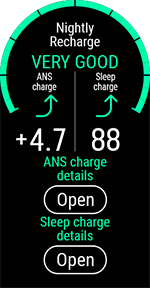

How ANS charge is measured?
ANS charge gives you information on how well your autonomic nervous system (ANS) calmed down during the night. The scale is from -10 to +10. Around zero is your usual level. Your ANS controls two sets of actions your body can take: whether it's time to fight or flight (sympathetic nervous system), or if it's time to rest and digest (parasympathetic nervous system). The higher the ANS charge, the higher the dominance of the rest-and-digest part of ANS compared to your usual level. ANS charge compares the recovery of your ANS to your usual level from the past 28 days.

ANS charge is based on the analysis of your heart’s beat-to-beat interval data, which is measured optically from your wrist. The three parameters forming the ANS charge heart rate, heart rate variability and breathing rate are measured during roughly the first four hours of your sleep. The first hours of sleep are more sensitive to reflect recovery than measurements averaged from a whole night's sleep. The first hours of sleep are also important for physical recovery as most of your deep sleep occurs then.
First your heart’s beat-to-beat interval data is converted into heart rate, heart rate variability (RMSSD) and breathing rate. Then these three parameters are combined into one single value to form your ANS charge value. Heart rate has the biggest influence when forming the score and breathing rate the smallest. The effects of stress on your body can be seen in the functioning of your ANS. After a demanding day, it takes more time than usual to switch from activation into relaxation mode, which is reflected in the ANS charge. To get a higher ANS charge your heart rate would need to be lower, heart rate variability higher and breathing rate lower than usual.
For example mental or physical stress, exercising late at night, illness, or alcohol can keep your heart rate up (and heart rate variability down) during the early hours of your sleep.
Heart rate is mainly regulated by the ANS. Your average heart rate during roughly the first four hours of sleep is measured. A normal value for adults can range between 40 and 100 bpm. It is common for your heart rate values to vary between nights. It's best to compare your last night's value to your usual level.
Heart rate variability (HRV) refers to variation in the time between successive heart beats. A higher HRV reflects the higher activation of the part of ANS responsible for resting and digesting. In general, high heart rate variability is linked to general good health, high cardiovascular fitness and resilience to stress. It can vary greatly from person to person, ranging from 20 to 150. It's best to compare your last night's value to your usual level.
Breathing rate shows your average breathing rate during roughly the first four hours of sleep. It is calculated from your beat-to-beat interval data. Your beat-to-beat intervals shorten when you breathe in and lengthen when you breathe out. During sleep, breathing rate slows down and varies mainly along with sleep stages. Typical values for a healthy adult at rest range from 12 to 20 breaths per minute. Your breathing rate doesn't normally vary a lot. Higher values than usual may indicate a fever or impending illness.
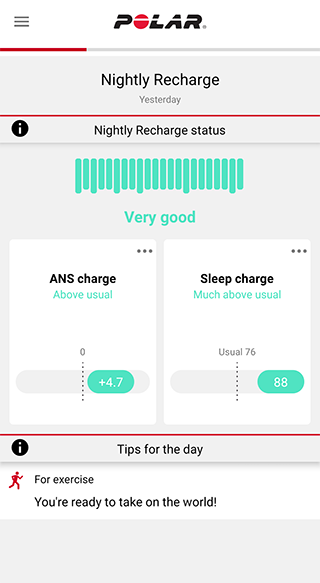
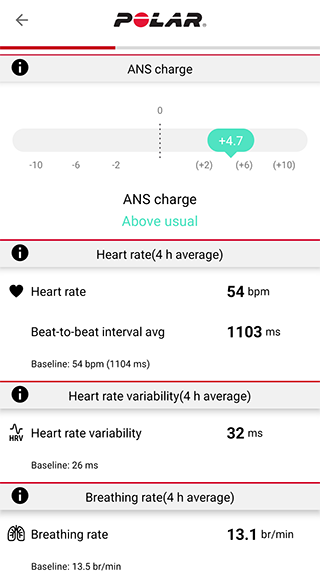
How sleep charge is measured?
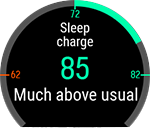
Your Sleep charge looks at how you slept last night compared to your usual level. Your sleep score is a number that summarizes how much and how well you've slept. This score is compared to your usual scores from the past 28 days. The scale of the sleep score is 1 - 100. A typical sleep score is around 70 to 85.
Sleep charge = Sleep score compared to your usual level. Scale: much below usual – below usual – usual – above usual – much above usual. The green color means your charge was usual or better than usual.
The six components of the sleep score are grouped under three themes: amount, solidity and regeneration. Each bar in the sleep graph represents the score for each component. Sleep score is the average of these scores.

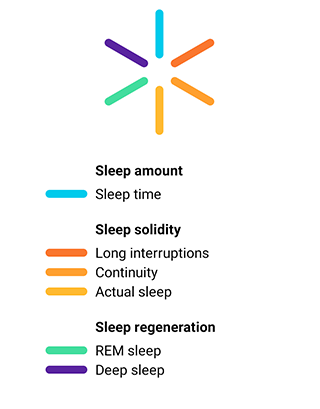
Sleep amount looks at how long you've slept. Getting enough sleep is crucial to your wellbeing. Your sleep time is compared to the optimal sleep time based on your preferred sleep time setting and the age-related sleep duration recommendations (7 - 9 h for adults). Sleep time tells you the total duration between when you fell asleep and when you woke up. On average, adults sleep for 7 h 20 min, with women sleeping slightly longer than men. Your usual level shows how this component was usually scored during the past 28 days.
Sleep solidity looks at the quality of your sleep in terms of the number and pattern of interruptions in your sleep. Your usual level shows how this component was usually scored during the past 28 days. A good night's sleep consists of long, uninterrupted periods. However, it's perfectly normal to have some interruptions in your sleep - in most cases you won't even remember being awake. The components of the solidity theme are evaluated against the indicators of good sleep quality based on the current sleep research literature.
- Long interruptions (min) tells the time you spent awake during the interruptions that were longer than 90 seconds. Interruptions in sleep are perfectly normal. During a normal night's sleep there are numerous short and long interruptions when you awaken from your sleep. Whether you remember these interruptions or not depends on their duration. The shorter ones we don’t usually remember. The longer ones, for instance when one might get up for a sip of water, we can remember. There are about 15 minutes of long interruptions in sleep during an average night. A night without any long interruptions gives the maximum score.
- Continuity (1-5) Sleep continuity is a rating of how continuous your sleep was on a scale of 1 to 5. 5 represents sleep without any interruptions. Values higher than 3 reflect long stretches of sleep with occasional interruptions. Values lower than 3 reflect sleep in short segments with several interruptions. The average value for adults is 3.2. Lower values are common when you sleep longer, as sleep becomes lighter after the most pressing need for sleep has been met.
- Actual sleep (%) Actual sleep is your sleep time minus interruptions. It shows in percentages how much of your night was spent asleep. For adults, the average value for actual sleep is 93 %. The closer the value is to 100 %, the higher the score for actual sleep.
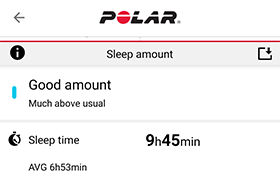
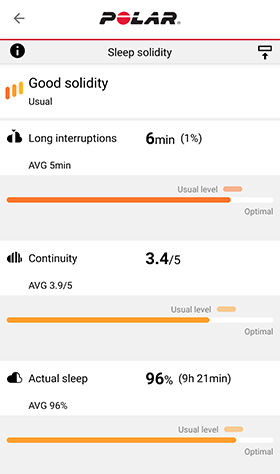

A healthy adult normally goes through 4-5 sleep cycles over the course of a night. Normally sleep cycles proceed from light sleep into deep sleep, and then back to REM sleep. Sleep regeneration looks at the quality of your sleep in terms of the proportions of restorative sleep stages: REM sleep and deep sleep. REM sleep is important for learning and memory. Deep sleep restores your body. A healthy sleep structure contains a good amount of both REM sleep and deep sleep. Your usual level shows how this component was usually scored during the past 28 days. The components of the regeneration theme are evaluated against the indicators of good sleep quality based on the current sleep research literature.
- REM sleep %: REM stands for rapid eye movement. In REM sleep, your muscles are relaxed but your brain is active. REM sleep restores your mind, and enhances memory and learning. This is the stage when dreaming mostly occurs. Most REM sleep occurs during the second half of the night. The amount of REM sleep is on average about 21 % of sleep time for adults. 25 % gives the maximum score from this component of sleep score. Higher or lower percentages decreases your score.
- Deep sleep %: Deep sleep is the stage of sleep when it's hardest to be woken up. This sleep stage restores your body, supports your immune system and affects muscle growth. It also affects certain aspects of memory and learning. Most deep sleep occurs during the first half of the night. On average, deep sleep counts for about 15 % of sleep time for adults. Roughly 17 % gives you the maximum score for this sleep score component. A higher percentage does not improve your score.
- Light sleep %: Light sleep serves as a transition stage between wakefulness and the deeper stages of sleep. You can be easily awoken from light sleep since your responsiveness to the environmental stimuli remains quite high. Light sleep also promotes mental and physical recovery, although REM and deep sleep are the most important sleep stages in that regard.
Sleep rhythm: Regular bedtimes teach your body to anticipate sleep, which makes falling asleep easier when it's time. Keeping your bedtimes consistent is one of the simplest tricks to get the optimal amount of all the necessary sleep stages. A consistent sleep rhythm reinforces a healthy sleep structure.
For further information, see Sleep Plus Stages™ sleep tracking.
How to start using Nightly Recharge?
- Wear your watch when you sleep. You need to wear your watch for three nights before you start to see the Nightly Recharge status on your watch.
- Continuous heart rate tracking needs to be enabled for Nightly Recharge to function. To enable Continuous HR tracking go to Settings > General Settings > Continuous HR tracking and select On or Night-time only. Tighten the wristband firmly around your wrist. The sensor on the back must be in constant touch with your skin. For more detailed wearing instructions, see Troubleshooting optical heart rate measurement
- After three successful nightly measurements you will start to see your Nightly Recharge status on your watch.
Analyze your Nightly Recharge in the Flow app
You can compare and analyze your Nightly Recharge details from different nights in the Polar Flow app. Choose Nightly Recharge from the Flow app menu to see the details of your last night's Nightly Recharge. Swipe the display right to see the Nightly Recharge details for previous days. Tap the ANS charge or sleep charge box to open a detailed view of ANS charge or sleep charge.
.png)


ANS charge is based on the analysis of your heart’s beat-to-beat interval data, which is measured optically from your wrist. ANS charge gives you information on how well your autonomic nervous system (ANS) calmed down during the night. The scale is from -10 to +10. Around zero is your usual level. The ANS charge is formed by measuring your heart rate, heart rate variability and breathing rate during roughly the first four hours of sleep.
Sleep charge details in the Flow app
How you sleep is always individual — instead of comparing your sleep stats to others, follow your own long-term sleeping patterns to analyze how you sleep.
Sync your watch with the Flow app after waking up to see your last night’s sleep data in Polar Flow. Follow your sleep on a daily and weekly basis in the Flow web service and app, and see how your sleeping habits and daily choices affect the quality of your sleep.
Select Sleep from the Flow app menu to see your sleep data. In the sleep structure view you see how your sleep has progressed through different sleep stages (light sleep, deep sleep and REM sleep) and any interruptions to your sleep. Usually sleep cycles proceed from light sleep into deep sleep and then to REM sleep. Typically a night's sleep consists of 4 to 5 sleep cycles. This equals to approximately 8 hours of sleep. During a normal night's sleep there are numerous short and long interruptions shown in orange on the graph.


Sleep score describes how you slept compared to the indicators of a good night’s sleep based on the current sleep science. It summarizes the amount and quality of your sleep into a single number (1 - 100). The six components of the sleep score are grouped under three themes: amount (sleep time), solidity (long interruptions, continuity and actual sleep) and regeneration (REM sleep and deep sleep).
You can also rate your sleep yourself. You can rate how well you’ve slept last night with a five-step scale: very poorly - poorly – okay - well - very well. Your own rating is not taken into account in the sleep charge calculation, but you can record your own perception and compare it to the sleep charge assessment you get.

For further information, see Sleep Plus Stages™ sleep tracking.
Personalized tips in the Flow app
Based on what we've measured from you, you get personalized daily tips in the Polar Flow app on exercise, and tips on sleep and regulating your energy levels on those particularly rough days. Tips for the day are displayed on the opening view of Nightly Recharge in the Flow app.
For exercise
You get an exercise tip every day. It tells you if you should take it easy or go for it. The tips are based on:
- Nightly Recharge status
- ANS charge
- Sleep charge
- Cardio load status
For sleep
If you didn't sleep as well as usual, you get a sleep tip. It tells you how to improve the aspects of sleep that weren't as good as usual. Besides things we measure from your sleep, we take into account your:
- sleep rhythm over a longer period of time
- Cardio load status
- exercise on the previous day
For regulating energy levels
If your ANS charge status or sleep charge is particularly low, you get a tip that helps you get through the days with a lower recharge. They are practical tips on how to calm down when you're in overdrive and energize when you need a boost.

Scientific background
Nighty Recharge is based on up-to-date scientific knowledge on stress and recovery. It utilizes a generally accepted means to assess the function of the autonomic nervous system (ANS) and nightly sleep. Measuring the heart’s beat-to-beat intervals provides a valid tool to indirectly measure the ANS function as well as sleep in real-life settings.
ANS charge combines heart rate, heart rate variability and breathing rate smartly, in a way that reflects changes in the sympathetic and parasympathetic control of the heart. Heart rate is regulated by the both branches of the ANS. Activation of the sympathetic branch speeds heart rate up while activation of the parasympathetic branch slows it down. Variation in the heart’s beat-to-beat intervals (i.e. heart rate variability) is measured with a parameter called RMSSD (Root Mean Square of Successive Differences in beat-to-beat intervals). It especially reflects the parasympathetic control of the heart. The higher the parasympathetic activation, the higher the RMSSD value. Breathing rate can also be captured from the heart’s beat-to-beat interval data. It is typically quite stable from night to night but when it does deviate from its usual level, it adds meaningful information to the ANS charge.
Sleep charge is built on the Sleep Plus Stages feature. Polar’s automatic sleep measurement with the Sleep Plus Stages algorithm has been validated against polysomnography, which is the gold standard method to assess sleep. Sleep score is an easy to understand measure with a solid scientific basis. There is no single parameter that would indicate how well you slept, and therefore sleep score combines several components of sleep. These components have been formulated based on scientific sleep duration and quality recommendations.
Nightly Recharge on Polar Grit X
For more information see Nightly Recharge on your watch in Polar Grit X User manual.
Nightly Recharge on Polar Grit X Pro
For more information see Nightly Recharge on your watch in Polar Grit X Pro User manual.
Nightly Recharge on Polar Grit X2 Pro
For more information see Nightly Recharge on your watch in Polar Grit X2 Pro User manual.
Nightly Recharge on Polar Ignite
For more information see Nightly Recharge on your watch in Polar Ignite User manual.
Nightly Recharge on Polar Ignite 2
For more information see Nightly Recharge on your watch in Polar Ignite 2 User manual.
Nightly Recharge on Polar Ignite 3
For more information see Nightly Recharge on your watch in Polar Ignite 3 User manual.
Nightly Recharge on Polar Pacer
For more information see Nightly Recharge on your watch in Polar Pacer User manual.
Nightly Recharge on Polar Pacer Pro
For more information see Nightly Recharge on your watch in Polar Pacer Pro User manual.
Nightly Recharge on Polar Unite
For more information see Nightly Recharge on your watch in Polar Unite User manual.
Nightly Recharge on Polar Vantage M
For more information see Nightly Recharge on your watch in Polar Vantage M User manual.
Nightly Recharge on Polar Vantage M2
For more information see Nightly Recharge on your watch in Polar Vantage M2 User manual.
Nightly Recharge on Polar Vantage V
For more information see Nightly Recharge on your watch in Polar Vantage V User manual.
Nightly Recharge on Polar Vantage V2
For more information see Nightly Recharge on your watch in Polar Vantage V2 User manual.
Nightly Recharge on Polar Vantage V3
For more information see Nightly Recharge on your watch in Polar Vantage V3 User manual.